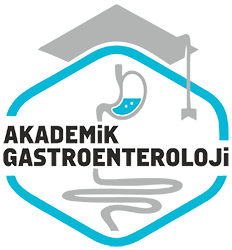Aralik 2007
Reflü özofajit ile Helikobakter pilori ve gastrit ilişkisi
The relation between Helicobacter pylori gastritis, and reflux esophagitis
- Ana Sayfa
- Sayılar
- Aralik 2007
- Reflü özofajit ile Helikobakter pilori ve gastrit ilişkisi...
Özet
Giriş ve Amaç: Helikobakter pilori enfeksiyonu ile gastroözofageal reflü hastalığı arasındaki ilişki tartismalidir. Bu çalışmanın amacı Helikobakter pilori?nin varligi ve Helikobakter pilori gastritinin histolojik ve topografik özellikleri ile özofajit şiddeti arasındaki ilişkiyi araştırmakti. Gereç ve Yöntem: çalışmaya endoskopide reflü özofajit saptanan toplam 129 (84 erkek ve 45 kadın) hasta alındı. Tüm Hastaların yaş, cinsiyet, alkol kullanma öyküsü ve reflü semptomları, cerrahi öyküsü sorgulandi. Reflü özofajit şiddeti Los Angeles klasifikasyonuna göre yapildi. Bütün hastalardan antrum ve korpustan biyopsiler alındı. Gastrit için histopatolojik inceleme Sydney siniflama sistemine göre yapildi. Bulgular: Hastaların %44.2?sinde evre A, % 46.5?inde evre B, %8.5?inde evre C ve %0.8?inde evre D özofajit izlendi. Toplam Helikobakter pilori pozitiflik orani %73, antrumda %68.2, korpusta %68.2 idi. Antrum ve korpusta Helikobakter pilori varligi, şiddeti ve dagilimi ile özofajit evresi arasında anlamli bir ilişki yoktu. Sydney sistemine göre Helikobakter pilori dışındaki gastrit için tanımlanan diğer parametrelerle özofajit evresi arasında da anlamli bir ilişki yoktu. Inflamasyon oranlari antrum ve korpusta benzerdi (sirayla %95.3 ve %92.2). Antrumdaki atrofi sikligi (%58.1) korpustaki atrofi sikligina (%24) göre anlamli olarak daha yüksekti. Aktivasyon sikligi antrumda (%66.7) korpusa göre (%47.3) anlamli olarak daha yüksekti. Sonuç: Özofajitli hastalardaki Helikobakter pilori sikligi ülkemiz için bildirilen Helikobakter pilori sikligina benzer bulunmustur. Kronik aktif gastrit ve kronik atrofik gastrit antrumda korpusa göre anlamli şekilde daha yüksekti. Bu bulgular Helikobakter pilori?nin varligindan ziyade olusturdugu histolojik gastrit tipinin özofajit ile ilişkili olabilecegini düsündürmektedir.
Abstract
Background and aim: The relation between gastroesophageal reflux disease and Helicobacter pylori infection is controversial. The aim of this study was to investigate the relation between the presence of Helicobacter pylori and the histological and topografical features of Helicobacter pylori gastritis, and the severity of esophagitis. Material and methods: 129 patients (84 male and 45 female) with esophagitis diagnosed during upper gastrointestinal endoscopy were enrolled into the study. Ages of patients, gender, alcohol abuse and symptoms of reflux disease, medical history of surgery were also recorded. Los Angles classification was used for reflux esophagitis. Biopsies from antrum and the body of stomach were obtained. Sydney classification was used for gastritis. Results: Grade A esophagitis was found in 44,2% of all patients, grade B esophagitis in 46,5%, grade C esophagitis in 8.5% and grade D esophagitis in 0.8%. Total Helicobacter pylori rate was 73%, 68,2% in antrum and 68,2% in the body of stomach. There was no significant association between the presence, severity and distribution of Helicobacter pylori in antrum and the body of stomach and the severity of esophagitis. There was no significant association the presence of activation, inflamation, atrophy and intestinal metaplasia in both location and the severity of esophagitis. The rates of inflamation was similar in antrum and the body of stomach (%95.3 and %92.2). The rate of activation was significantly higher in antrum (66.7%) than in the body of stomach (47.3%). The rate of atrophy was significantly higher in antrum (58.1%) than in the body of stomach (24%). Conclusion: The frequency of Helicobacter pylori in patients with esophagitis was similar to the frequency reported in our country. Chronic active gastritis and chronic atrophic gastritis was more frequent in the antrun than in the body of stomach. These findings indicate that the types of histological gastritis caused by Helicobacter pylori rather than the presence of Helicobacter pylori is associated with esophagitis.



